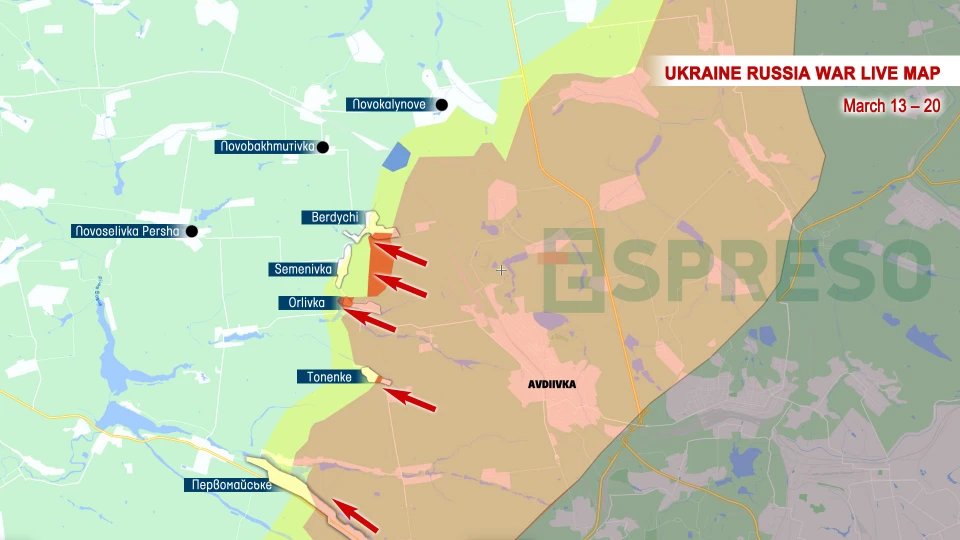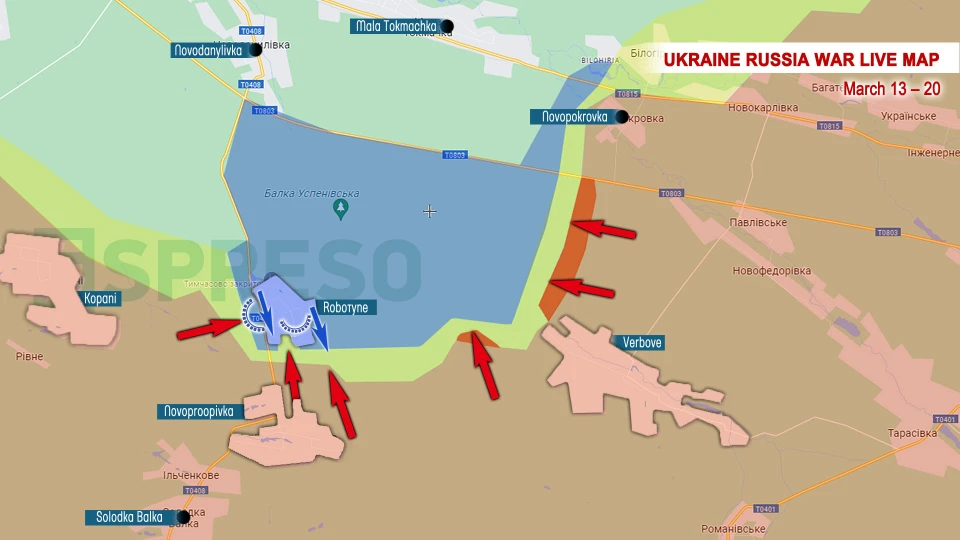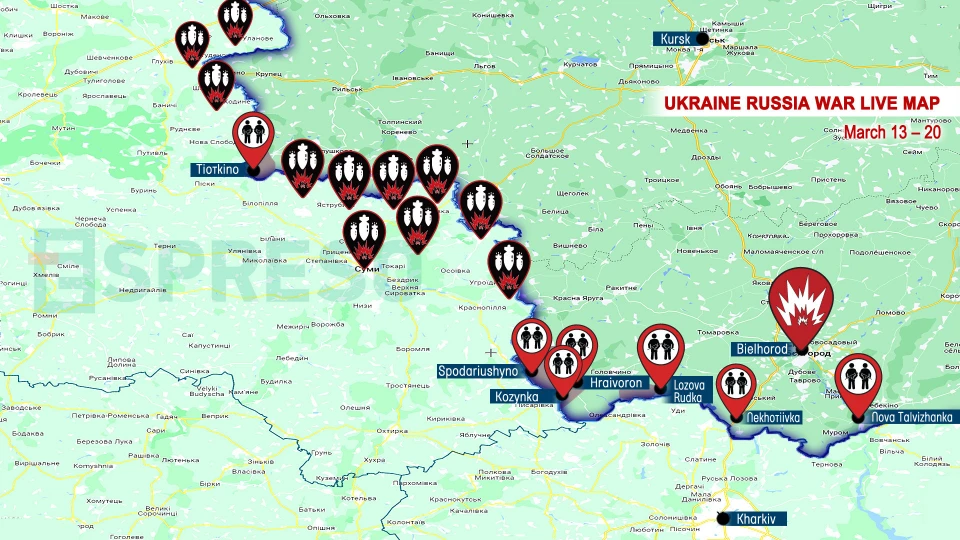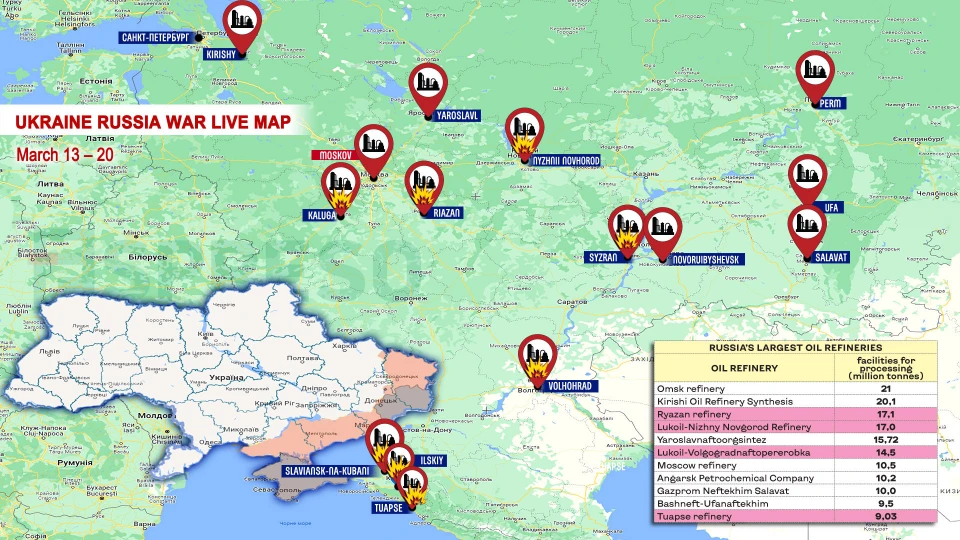
Map of hostilities for March 13-20: Russia burns but terrorize Sumy region, frontline fights back
Over the decade-long conflict with Russia, the week preceding Putin's reappointment became most tumultuous for Russian residents, particularly in Bilhorod. Meanwhile, the Ukrainian Army successfully deter Russian forces on most fronts
To maintain the pace of their advance across all frontlines, the Russians are mobilizing their new strategic reserves, particularly near Kupyansk, Chasiv Yar, and Robotyne.
Avdiivka front weekly update
The Russian troops continue to advance towards the Ukrainian main defensive line in the Avdiivka direction, suffering significant losses in the process. However, their progress has significantly slowed down, and most "cannon fodder" attackers are physically eliminated by Ukrainian soldiers. Nevertheless, defense forces cannot indefinitely hold onto completely destroyed villages. In the past week, the Russians have managed to almost completely occupy Orlivka, seize the southern part of Berdychi, and advance in the southern part of Lastochkine. The overall depth of their advance to the west does not exceed 1 km. In the near future, it is likely that Russian forces will completely push back the Ukrainian Defense Forces from Orlivka and Lastochkine, and then bump into the water obstacle.
Recently, a video was posted online showing how Bradley destroyed an enemy APC and all its "passengers" during an assault by the Russian army on the village of Berdychi. A curious fact: some of them were drafted in early March. This indicates how much the invaders were in a hurry to show results and break through the front near Avdiivka on the eve of Putin's so-called election. However, they failed.

Further south on this front, the Russian troops attacked the village of Nevelske, which from the south covers the enemy's advance towards Pervomaiske. The occupiers even claimed to have captured the settlement, but this information turned out to be fake. Therefore, it is expected that the assault on the village will continue in the near future so that the Russians can justify themselves to their leadership.
Luhansk and Donetsk regions
Throughout the week, the Russian forces, as before, attempted to break through Ukrainian defense lines in the Kupyansk and Lyman directions in Luhansk region, as well as in Chasiv Yar, Hеorhiivka, and Novomykhailivka in Donetsk region. However, all of these attempts were repelled. The most intense battles took place in the central parts of the villages Ivanivske and Novomykhailivka, which hold tactical significance for maintaining the defense of Chasiv Yar and Vuhledar.

Robotyne, Zaporizhzhia Tokmak direction
It has been about a month since the Russians became more active on the southern front to nullify the results of the Ukrainian Armed Forces' summer counteroffensive. While in the Berdiansk sector, near Staromayorske, the Defense Forces are successfully holding back the invaders, the situation near the Robotyne bulge is getting more and more tense.
The Russian forces are advancing on Robotyne from three sides, attempting to to bite off the de-occupied land in pieces. Throughout the week, they have expanded the gray zone from the southern outskirts of the village and intensified assaults from the western side. For several days, heavy counterattacks have been ongoing between Robotyne and Verbove. Initially, the Russian troops broke through from the south and east, but the Ukrainian Armed Forces first withdrew, then pushed back the enemy to their initial positions. However, the second wave of invaders managed to push back the Ukrainian Defense Forces several kilometers west of Verbove, effectively narrowing down the Robotyne bulge by almost a kilometer, which is already heavily fortified. It is likely that this section of the front will become one of the most tense in the near future.

Map of military operations in Russia: Raid in the southern regions
Despite the fact that the second raid by Russian volunteers in the Belgorod and Kursk regions is ongoing, it can already be assessed as more successful than the first one, which took place almost a year ago. This time, the Russian Volunteer Corps and the Freedom of Russia Legion were joined by the newly created Siberian Battalion. By increasing their numbers, the volunteers also managed to expand the geography of their raid and make the campaign longer.
While battles in the Kursk region were confined to the border village of Tyotkino, in Bilhorod, they spread across an almost 100-kilometer zone, reaching villages near the town of Hayvoron, the settlement of Horkivskyi, and Lozova Rudka, as well as Zhuravlivka and Nova Tavilzhanka. Bilhorod found itself under daily drone strikes and shelling from its own air defense systems. The Russians have deployed a 35,000-strong contingent in this territory, primarily aimed at covering the border, securing logistical routes, and preparing reserves. After a week of fighting, the Russian occupation forces have failed to gain control over their own border and eliminate a number of gray uncontrolled zones established by Russian volunteers. Moreover, the trend suggests that gray zones along the border will increase, potentially evolving into a hybrid platform over time.
Instead, terrorist Russia opened heavy fire with artillery, MLRS and even dropped aerial bombs on the villages of Sumy region.

Russian gas station on fire
Over the course of 7 days, the Security Service of Ukraine (SBU) and the Main Intelligence Directorate (HUR) successfully targeted 6 oil refineries, with 5 of them being hit effectively. Particularly valuable were the strikes on the Ryazan and Kstovo (Nizhny Novgorod) refineries, which are among the top 5 largest refineries and collectively process 10% of the oil, or 34 million tons. Additionally, fires broke out at refineries in Slavyansk-on-Kuban, Syzran, and Pervyi Zavod in the Kaluga region, which together have the capacity to process 12 million tons of oil, or 4% of the Russian industry. Unfortunately, the strike on the Novokuibyshevsk refinery was unsuccessful. The 1,000-kilometer range of Ukrainia drones covers about 70% of the refining capacity in Russia. Taking into account the previous strikes on the refinery in January and February, it is likely that our strikes affected about 20% of the refinery's 80 million tons of oil refining capacity.
The maps were created based on information received from the General Staff of the Armed Forces of Ukraine, as well as other open and verified sources. At the same time, the maps are not as accurate as possible and only conditionally reflect trends in the combat zone.
- News












































